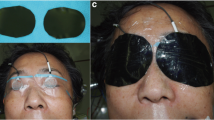Abstract
Background
Visual evoked potential (VEP) has been installed as one of the intraoperative visual function monitoring. It remains unclear, however, whether intraoperative VEP monitoring facilitates as a real time visual function monitoring with satisfactory effectiveness and sensitivity. To evaluate this, relationships between VEP waveform changes and postoperative visual function were analysed retrospectively.
Methods
Intraoperative VEP monitoring was carried out for 106 sides (eyes) in 53 surgeries, including two intraorbital, 36 parasellar and 15 cortical lesions in Shinshu University Hospital under total intravenous anaesthesia. Red light flash stimulation was provided to each eye independently. VEP recording and postoperative visual function were analysed.
Results
In 103 out of 106 sides (97%), steady VEP monitoring was recorded. Stable VEP was acquired from eyes having corrected visual acuity greater than 0.4. VEP was not recorded in one side with corrected visual acuity of 0.3 and two sides in whom sevoflurane was used incidentally for anaesthesia. Transient VEP decrease was observed in three sides, but visual function was preserved. Permanent VEP decrease was seen in seven sides, which presented visual impairment postoperatively. In one side, visual acuity improved but minor visual field defect was encountered postoperatively, though VEP unchanged throughout the surgery.
Conclusions
Intraoperative monitoring of VEP predicts postoperative visual function: reversible change in VEP means visual function to be preserved. Visual field defect without decrease in the visual acuity may not be predicted by VEP monitoring. Intraoperative VEP monitoring will be mandatory for surgeries harbouring a risk of visual impairment.




Similar content being viewed by others
References
Sasaki T, Ichikawa T, Sakuma J, Suzuki K, Matsumoto M, Itakura T, Kodama N, Murakawa M (2006) Intraoperative monitoring of visual evoked potentials. Masui 55:302–313
Sasaki T, Itakura T, Suzuki K, Kasuya H, Munakata R, Muramatsu H, Ichikawa T, Sato T, Endo Y, Sakuma J, Matsumoto M (2009) Intraoperative monitoring of visual evoked potential: introduction of a clinically useful method. J Neurosurg : published online February 6, 2009; doi:10.3171/2008.9.JNS08451.
Albright AL, Sclabassi RJ (1985) Cavitron ultrasonic surgical aspirator and visual evoked potential monitoring for chiasmal gliomas in children. Report of two cases. J Neurosurg 63:138–140
Chacko AG, Babu KS, Chandy MJ (1996) Value of visual evoked potential monitoring during trans-sphenoidal pituitary surgery. Br J Neurosurg 10:275–278
Costa e Silva I, Wang AD, Symon L (1985) The application of flash visual evoked potentials during operations on the anterior visual pathways. Neurol Res 7:11–16
Feinsod M, Selhorst JB, Hoyt WF, Wilson CB (1976) Monitoring optic nerve function during craniotomy. J Neurosurg 44:29–31
Goto T, Tanaka Y, Kodama K, Kusano Y, Sakai K, Hongo K (2007) Loss of visual evoked potential following temporary occlusion of the superior hypophyseal artery during aneurysm clip placement surgery. Case report. J Neurosurg 107:865–867
Harding GF, Bland JD, Smith VH (1990) Visual evoked potential monitoring of optic nerve function during surgery. J Neurol Neurosurg Psychiatry 53:890–895
Herzon GD, Zealear DL (1994) Intraoperative monitoring of the visual evoked potential during endoscopic sinus surgery. Otolaryngol Head Neck Surg 111:575–579
Hussain SS, Laljee HC, Horrocks JM, Tec H, Grace AR (1996) Monitoring of intra-operative visual evoked potentials during functional endoscopic sinus surgery (FESS) under general anaesthesia. J Laryngol Otol 110:31–36
Jones NS (1997) Visual evoked potentials in endoscopic and anterior skull base surgery: a review. J Laryngol Otol 111:513–516
Kamada K, Todo T, Morita A, Masutani Y, Aoki S, Ino K, Kawai K, Kirino T (2005) Functional monitoring for visual pathway using real-time visual evoked potentials and optic-radiation tractography. Neurosurgery 57(1 Suppl):121–127
Kodama K, Goto T, Sato A, Sakai K, Tanaka Y, Hongo K (2008) Intraoperative monitoring of visual evoked potential for aneurysm clipping surgery. Surg Cereb Stroke 36:350–354
Ota T, Kawai K, Kamada K, Kin T, Saito N (2009) Intraoperative monitoring of cortically recorded visual response for posterior visual pathway. J Neurosurg : published online July 24, 2009; doi:10.3171/2009.6.JNS081272
Wilson WB, Kirsch WM, Neville H, Stears J, Feinsod M, Lehman RA (1976) Monitoring of visual function during parasellar surgery. Surg Neurol 5:323–329
Wright JE, Arden G, Jones BR (1973) Continuous monitoring of the visually evoked response during intra-orbital surgery. Trans Ophthalmol Soc U K 93:311–314
Cedzich C, Schramm J, Fahlbusch R (1987) Are flash-evoked visual potentials useful for intraoperative monitoring of visual pathway function? Neurosurgery 21:709–715
Cedzich C, Schramm J, Mengedoht CF, Fahlbusch R (1988) Factors that limit the use of flash visual evoked potentials for surgical monitoring. Electroencephalogr Clin Neurophysiol 71:142–145
Cedzich C, Schramm J (1990) Monitoring of flash visual evoked potentials during neurosurgical operations. Int Anesthesiol Clin 28:165–169
Wiedemayer H, Fauser B, ArmbrusSater W, Gasser T, Stolke D (2003) Visual evoked potentials for intraoperative neurophysiologic monitoring using total intravenous anesthesia. J Neurosurg Anesthesiol 15:19–24
Wiedemayer H, Fauser B, Snddalcioglu IE, Armbruster W, Stolke D (2004) Observation on intraoperative monitoring of visual pathways using steady-state visual evoked potentials. Eur J Anesthesiol 21:429–433
Nakagawa I, Hidaka S, Okada H, Kubo T, Okamura K, Kato T (2006) Effects of sevoflurane and propofol on evoked potentials during neurosurgical anesthesia. Masui 55:692–698
Conflict of interest
The authors declare that they have no conflict of interest.
Author information
Authors and Affiliations
Corresponding author
Rights and permissions
About this article
Cite this article
Kodama, K., Goto, T., Sato, A. et al. Standard and limitation of intraoperative monitoring of the visual evoked potential. Acta Neurochir 152, 643–648 (2010). https://doi.org/10.1007/s00701-010-0600-2
Received:
Accepted:
Published:
Issue Date:
DOI: https://doi.org/10.1007/s00701-010-0600-2




